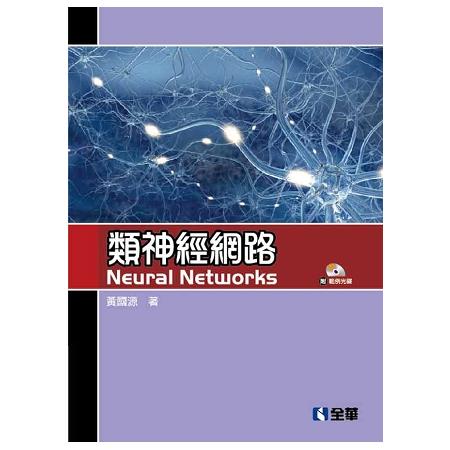金石堂網路書店 購物推薦 類神經網路(第三版)(附範例光碟)
類神經網路(第三版)(附範例光碟)
類神經網路(第三版)(附範例光碟) 評價
網友滿意度:

有人說
閱讀 是從有限的物質世界
到達無限的思想空間最快的方法
每本書都是開啟新世界的門窗
閱讀使我在新世界裡暢遊
一句句 一頁頁
各式各樣的角色人物
像我呼喚
帶領著我一起遨遊
直至最後一頁
在博客來看到
類神經網路(第三版)(附範例光碟)
相信這本書大家都挺面熟的
沒錯這可是超級暢銷書呀
小編我最喜歡看書了
已經練就到了
一目十行的高深功力
而#GOODS_NAME#
真的是人人稱讚的一本好書
我反覆咀嚼其字字句句
便覺得韻味非常
想把這本書推薦給你們
跟我一起進入新世界
下面有連結和折價卷
也可以加入金石堂的粉絲專頁
定期都有好書推播通知唷~~~
類神經網路(第三版)(附範例光碟)
|
地政士考試之寶刀屠龍  |
土地法規歷屆試題全解-測驗&申論完全攻略(地政士、不動產經紀人、不動產估價師考試適用)  |
商品訊息功能:
商品訊息描述:
《類神經網路(第三版)(附範例光碟)》
人類的頭腦約由1011 個神經元所組成,所有的訊息就在神經元與神經元間靠著軸突及樹突的發送與接收來傳遞。在這樣的一個過程中,所接收進來的各種訊息被分類或辨認,進而形成了人類的認知與思維。現在我們利用數學的計算來模擬神經元的運作,進而模擬神經網路的傳送,以期達到分類或辨認。類神經網路的特點為學習,學習的目的是要調整神經腱的大小,即調整加權係數,我們要探討各種就是學習法則。的類神經網路的模型及其加權係數的調整公式,也
本書著重於利用類神經網路的方法於圖形辨識與最佳化問題之解決,因此將先介紹傳統的識別方法,再介紹類神經網路的各種理論及模型。本書提供基本的例子讓讀者容易了解,容易進入類神經網路的領域,在探討的多個模型中,均有自己提出的見解。
本書特色
1.本書著重於利用類神經網路的方法於模式辨別與最佳化問題之解決。
2.提供基礎範例讓讀者容易了解,容易進入類神經網路的領域。
3.在何普菲模型應用於解銷售員旅行問題(TSP) 走最短距離的迴旋距離的優化,有詳細的分析;在何普菲類神經網路及一般化的蜂窩神經網絡也有做基本的介紹。
類神經網路(第三版)(附範例光碟)-目錄導覽說明
- 第一章 簡介
1.1 圖型的定義與圖型識別的方法
1.2 Decision-theoretic Approach的圖形識別與空間分割
1.3 Pattern Recognition Systems
1.4 Non-parametric & Parametric Methods
1.5 人類頭腦的Neuron與模擬的Perceptron
1.6 Two Class Data分佈的複雜性
1.7 Activation Function
1.8 Development History of Neural Networks
1.9 Neural Network Applications
第二章 DECISION-THEORETIC PATTERN RECOGNITION 決策理論的圖形識別
Decision-theoretic Approach的圖形識別與Discriminant Functions
2.2 Nonparametric Pattern Recognition非參數式之圖形識別:
Using Discriminant Functions
2.2.1 Linear discriminant functions for pattern recognition
2.2.2 Nonlinear discriminant functions for pattern recognition
2.2.3 Perpendicular bisector
2.2.4 Minimum-distance classifier
2.2.5 Minimum-distance classifier with respect to point sets (Piecewise-linear discriminant functions, Nearest-neighbor classification)
2.2.6 N-nearest neighbor classification rule
2.3 Parametric Pattern Recognition 參數式之圖形識別
2.3.1 Bayes theorem (貝氏定理) and probability density function (pdf)
2.3.2 Bayes (Parametric) classification rule (貝氏分類法則)
2.3.3 Sequential classification
2.3.4 Neyman-Pearson test
2.3.5 Linear Classifier Design
2.3.6 Feature selection
2.3.7 Error estimation
2.4 Unsupervised Pattern Recognition
2.4.1 Minimum spanning tree (MST) clustering
2.4.2 K-means clustering
2.4.3 Hierarchical Clustering Using Dendrogram (Unsupervised Clustering) 2
第三章 PERCEPTRON 認知器數學上解Decision Boundary之困難
3.2 Perceptron
3.3 Classification
3.4 Training (Learning)
3.5 Flowcharts of Perceptron
3.6 Convergence Proof of Perceptron for Fixed Increment Training Procedure
3.7 Perceptron for Logic Operation
3.8 Layered Machine (Committee Machine/Voting Machine)
3.9 Multiclass Perceptrons
3.10 Perceptron with Sigmoidal Activation Function and Learning by
Gradient Descent Method
3.11 Modified Fixed-increment Training Procedure
3.12 Multiclass Perceptron with Delta Learning Rule
3.13 Widrow-Hoff Learning Rule
3.14 Correlation Learning Rule
第四章 MULTILAYER PERCEPTRON 多層認知器 Introduction
4.2 設計Multilayer Perceptron with 1 Hidden Layer 解XOR的分類問題
4.3 Gradient and Gradient Descent Method in Optimization
4.4 Multilayer Perceptron (MLP) and Forward Computation
4.5 Back-propagation Learning Rule (BP)
4.5.1 Analysis
4.5.2 Back-propagation learning algorithm of one-hidden layer perceptron (I)
4.5.3 Back-propagation learning algorithm of one-hidden layer perceptron (II)
4.6 Experiment of XOR Classification & Discussions
4.7 On Hidden Nodes for Neural Nets
4.8 Application - NETtalk:A Parallel Network That Learns to Read Aloud
4.9 Functional-Link Net
第五章 RADIAL BASIS FUNCTION NETWORK (RBF) 輻射基底函數網路 Introduction
5.2 RBF Network 第一層的Learning Algorithm
5.3 RBF Network 第二層的Learning Algorithm
5.4 設計RBF Model to Classify XOR Patterns
第六章 SUPPORT VECTOR MACHINE (SVM) 支持向量的分類器Introduction
6.2 點到Hyperplane之距離
6.3 Role of Support Vectors in Optimal Margin Classifier for Linearly
Separable Case
6.4 Find Optimal Margin Classifier for Linearly Separable Case
6.5 SVM for Nonseparable Patterns
6.5.1 Primal Problem
6.5.2 Dual Problem
6.6 Feature Transformation and Support Vector Machine (SVM) – Kernel
SVM
6.6.1 Primal Problem and Optimal Separating Hyperplane之建立
6.6.2 在Dual Problem上求解新的Feature Space上的Support Vector Machine
6.6.3 Gradient Ascent的調適性的方法求 Lagrange Multipliers
6.7 Multiclss Classification Using Support Vector Machine
6.7.1 Maximum Selection Classification System Using SVMs
6.7.2 利用SVM 於數字辨識的樹狀分類系統 (Tree Classification System)
6.7.3 Multi-class Classification Using Many Binary SVMs
6.8 SVM Examples
6.8.1 直接利用Lagrange method (沒有利用KKT conditions 的Lagrange
method)
6.8.2 利用加入KKT 的Lagrange method
6.8.3 Support Vector Machine (SVM) Using Feature Transformation –
Kernel SVM
6.8 Exercise
語言:中文繁體
規格:平裝
分級:普級
開數:16開19*26cm
頁數:632
出版地:台灣
- 第一章 簡介
商品訊息簡述:
- 作者:黃國源
追蹤
- 出版社:全華
出版社追蹤

- 出版日:2017/9/7
- ISBN:9789864636280
- 語言:中文繁體
- 適讀年齡:全齡適讀
辦公桌風水盆栽
類神經網路(第三版)(附範例光碟)





 留言列表
留言列表